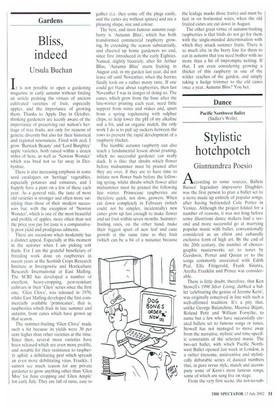Stylistic hotchpotch
Giannandrea Poesio
According to some sources, Ballets Russes' legendary impresario Diaghilev was the first person to plan a ballet set to a score made up entirely of popular songs, after having befriended Cole Porter in Venice. Although the project folded for a number of reasons, it was not long before some illustrious dance makers had a second and more successful go at marrying popular music with ballet, conventionally considered as an elitist and culturally exclusive form of high art. By the end of the 20th century, the number of choreographic masterworks set to tunes by Gershwin, Porter and Queen or to the songs commonly associated with Edith Piaf, Ella Fitzgerald, Frank Sinatra, Aretha Franklin and Prince was considerable.
There is little doubt, therefore, that Ken Stowell's 1998 Silver Lining, dubbed a ballet 'celebrating the genius of Jerome Kern', was originally conceived in line with such a well-affirmed tradition. It's a pity that, unlike George Balanchine, Maurice Bejart, Roland Petit and William Forsythe, to name but a few who have successfully created ballets set to famous songs or tunes, Stowell has not managed to move away from the narrative, stylistic and time-specific constraints of the selected music. The two-act ballet, with which Pacific Northwest Ballet opened last week in London, is a rather tiresome, uninventive and stylistically debatable series of danced numbers that, in pure revue style, match and accompany some of Kern's most famous songs, some of which are sung live on stage.
From the very first scene, the not-so-sub tie combination of ballet steps and musichall dancing fails to impress. Although the various members of the company do their best to switch seamlessly between genres, their inevitable limitations remain embarrassingly evident throughout. As a choreographer of the Parisian Moulin Rouge once told me after having rejected a too obviously 'ballet-trained' girl at an audition, 'there is a clear difference between a high kick and its balletic equivalent, a grand battement. The movement might be similar, but the dynamic quality and the artistic approach are worlds apart. Try to do one with the other in mind and you will look ridiculous.' In Stowell's work, though, it is not just the highly balleticised high kicks that look out of place. Apart from a series of unsuccessful attempts at swinging, gliding and hoofing away in the style of Fred and Ginger — to whom a large chunk of Act II is dedicated — one also finds that some well-known ballet sequences have been arbitrarily extrapolated from their original contexts and forcedly thrown in regardless of stylistic consistency.
I know for sure that I was not the only person who thought it odd seeing the end of the Don Quixote pas de deux — normally a number performed to fast circus-like music, in which the man spins at the centre while the ballerina moves around him with a quick series of turns — performed to the notes of 'Smoke Gets in Your Eyes'. Also completely out of place were the Balanchine-inspired solutions that punctuate the work from beginning to end, as if to pay respect to the father of American ballet.
Not every member of the audience reacted the way I did, though. On the opening night, this hotchpotch of choreographic and performing styles was received with great enthusiasm by some, who clearly found it very entertaining.
I wish I could say that the second programme, a rather oddly concocted mixed bill, was better. Alas, it was not. It kicked off with a rather flat performance of Divertimento #15 by Balanchine, continued with an equally unimpressive rendition of Nacho Duato's Jardi Tancat, which is normally one of the most poignant pieces by the Spanish dance maker, followed by an outrageously over-the-top performance of Le Corsaire pas de trios and concluded with Fearful Symmetries, a choreographic horror by New York City Ballet's current director. In each instance, what I found particularly upsetting was the overall quality of the dancing, which suffered from a lack of stylistic refinement and technical tidiness in the two more classical works, Divertimento #15 and Le Corsaire, and from a lack of dramatic drive required by Duato's piece. Let's hope that next time the company is back it will be with a better programme, more in line with that sparkling performance of Balanchine's A Midsummer Night's Dream that we saw in 1999.



































































 Previous page
Previous page